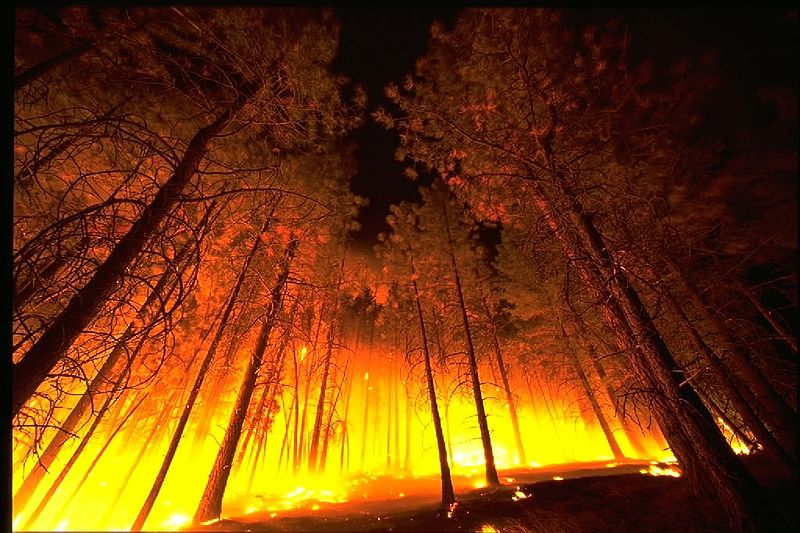Wildfires threaten regional stability with profound direct impacts at the community level. Yet the ecological, atmospheric, socio-economic impacts are inevitably transnational and often more abstract to comprehend in the short term. When thinking about wildfire management, it is crucial to keep in mind that neither fire nor smoke wait to present a passport before crossing political borders. The ultimate goal of politicians, citizens, and all inhabitants of fire-prone areas should be to improve community resilience. Can biomimicry help us get there?
The recent fires in Australia burned an area over twice the size of Portugal, with estimates nearing a billion animals lost along with critical habitat, food sources, and services the forests provide. The fires have set off a feedback loop that doubles down on climate change, releasing carbon trapped in organic plant matter and removing a main absorber of atmospheric carbon at the same time. Already the average annual temperature in Australia has increased by 1 degree Celsius within the past 100 years, a figure looming ever so close to the IPCC’s proposed limit of 1.5 degrees of change pushing the Earth beyond its ability to support existing life.
The ecological impact of these fires will surely be felt for years to come, in addition to the immediate economic damages, social welfare reductions, and human mortalities. The unprecedented extent of the destruction that Australia is facing in the aftermath of the 2019-2020 bushfire season should send up a different kind of flare than smoke – it’s time for society to adapt and prepare for the reality that a warmer climate means ‘once in a blue moon’ disasters might just be the new norm.
With the ashes of Australia’s southeastern forests still smoldering, it would be negligent to ignore this as a warning sign to bolster procedures in fire prevention, preparation, and ultimately community recovery for the future. Understanding the ecological resilience nature promotes through evolutionary adaption can help our built communities become more resilience. Could biomimicry offer a safer, more sustainable pathway in fire adaption and mitigation for humans?
One collaborative group of scientists from the University of Idaho and the University of Tasmania says yes. In a 2018 Nature publication, they proposed a revolutionary approach of how highly adapted wildlife can help people sustainably and safely coexist with fire. Over millennia, plants, animals, and many early human communities have developed to thrive in fire-prone regions. In trying to answer the question of how humans can learn to coexist with natural fires, the team of scientists sorted biological species into different categories of fire driven existences. According to Dr. Alistair Smith and his colleagues, these approaches include those that avoid fire, those that adapt to better tolerate fire, and those that have become dependent on fires.
Some plants avoid fire by moving key nutrients into their roots as a reserve for post-fire regrowth. This biochemical protection strategy is not necessarily something humans should think about in regard to self-preservation, but rather in the concept of underground storage of essential capital in fire prone areas. Adaptive plants, such as the Eucalyptus trees found in Australia’s bush, are structurally better prepared to take the heat of intense fires, with thicker barks protecting their internal life-giving structures. What about the structure of the bark offers heat protection? Can we learn from the bark as a blueprint to design fire-fighting materials in the same way?
Though not physically rooted in the ground, certain animals are intimately tethered to a specific community niche within a limited geographic region. Over time, they evolved to thrive in conditions of intense heat or fire prone areas rather than escape. From giant worms that call 150 degree pockets of the deep ocean home to desert snails with the perfect shell shape for self-cooling, nature is full of heat resilient creatures we can learn lessons in adaption from. Maybe understanding the biochemical composition of these worms could lead to heat resistant materials and coatings for buildings and homes, or the snail might be able to offer insight into architectural design for areas prone to drought.
Biomimicry as a learning framework and practice can also improve responses to the immediate impacts of wildfires, like fire spreading and smoke pollution. Some tree species, like the sequoias of Yellowstone National Park, release seeds when triggered by intense fire. This mechanism may reveal useful information on integrating retardant materials into the very structure of buildings. One hopeful design team from the University of Calgary hopes to address the issue of smoke pollution from wildfires. Their redesign of a conventional mesh filter mask is not only more efficient in capturing particulate matter, but it also improves comfort for the wearer, which increases widespread compliance. Drawing inspiration among the flexibility of bee hair and mammal eyelashes, this biomimetic wearable smoke filter relies on the smooth energy flow process of breathing to move stacked layers of hair.
While it might be hard at first to see how biomimicry can link evolutionary adaption to the complex social dynamics of human communities, we can’t forget that the fundamental principles apparent in evolutionary biology also apply to humans. And with modern technological advancements it’s reasonable that modern societies can feel disconnected to the land we live on. In the process of urbanization, modernization, and globalization, most contemporary societies have forgotten how many communities used fire to fight fire… preemptively.
“Humans in the past, as well as indigenous groups in tropical and subtropical ecosystems today, regularly used fire to support agricultural systems and manage ecosystem goods and services.” – Smith et. al (2018)
Many indigenous communities regularly use burnings as a management strategy to reduce the possible damage of inevitable wildfires. Firesticks Alliance is one organization uniting Aboriginal communities in collaboration with the Australian park system as well as private entities to reignite awareness of indigenous fire management practices. This organization provides an “opportunity for people to build on the knowledge they already have on country and look for ways to make use of new technologies and understandings as a way to support cultural identity and practice.” Fighting fire with fire might seem like a paradox, but it is a resurging movement that can greatly clear underbrush that would otherwise fuel unexpected wildfires.
People will sustainably coexist with our natural landscapes only when they are able to understand the role of prescribed fires for both rural and urban protection. Approaching fire through the lens of biomimicry reveals how past humans were better adapted to surviving wildfires than modern social systems are. We must reinvigorate human consideration of the entire ecosystem as a state of balance. To be in a position of stewardship for fire-prone communities, this means confronting the paradox of designated destruction actually ensuring long-term prosperity. Even planned fires may very well rage out of control, leading to a cascade of suffering in the ecosystem. There is a point at which biodiversity loss erases millions of years of research and development. But at what point are modern humans in such a superior position to ignore a rich, effective history of our ancestral mentors?
So what should we take away from the principles of biological interactions and the characteristics of nature’s resilient ecosystems? In a natural community, resilience is not necessarily the ability to survive adverse situations. Resilience is the capacity of the supporting biogeochemical systems of an ecosystem to recover in the aftermath of adverse situations. Some ecological communities exhibit more resilience than others. Most modern social communities of civil society parallel the complexity of natural ecological communities.
While the factors that contribute to community resilience for humans in our urban environments stray from the natural environment, we face many of the same natural hazards such as wildfires and droughts. The ultimate biomimetic test is if humans can translate nature’s hard-earned lessons in resiliency into better community preparedness, response, and revival in the face of natural disasters like wildfires – and if we can learn to value the wisdom of these ecosystems before the next fire alarm goes off.
 Isabelle Seckler is a first-year student at Columbia University in New York City. She intends to study sustainable development along with a pre-medical track with the hopes of advancing community prosperity at the intersection of our built and natural environments.
Isabelle Seckler is a first-year student at Columbia University in New York City. She intends to study sustainable development along with a pre-medical track with the hopes of advancing community prosperity at the intersection of our built and natural environments.
Twitter: @IzzySeckler | Instagram: @isabelle.seckler | Facebook: Isabelle (Izzy Seckler)

